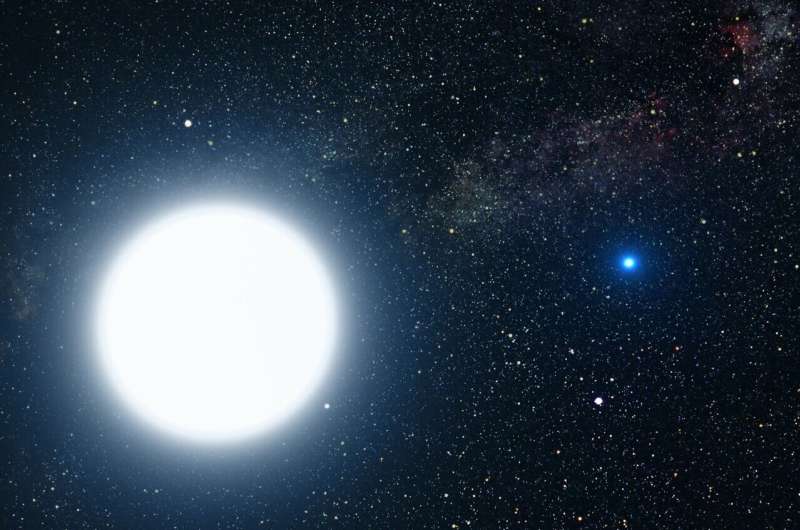
Credit: Pixabay/CC0 Public domain
The small footprint and faint light of white dwarfs, the remains of stars that have burned their fuel, can provide excellent settings for studying planets with enough water to support life.
The trick is to spot the shadow of a planet on an ancient star that has withered to a fraction of its size and discover that it is a planet that has retained its oceans of water for billions of years. years, even after overcoming the star’s explosive and violent final throes. A new study of the dynamics of white dwarf systems suggests that, in theory, some water planets could indeed thread the necessary celestial needles pending discovery and further examination.
Astronomers scanning planets outside our solar system (called exoplanets) for potential signs of life collect data as these planets transit their star or pass between the star and our telescopes. They use starlight passing through the thin layer of planets’ atmospheres to tell them what elements and molecules are present.
A huge star undergoing a full-scale nuclear fusion can be complicated and difficult to observe. So finding a planet orbiting a smaller, gentler white dwarf is less of the astronomical equivalent of squinting.
“White dwarfs are so small and featureless that if a terrestrial planet passed in front of them, we could actually better characterize its atmosphere,” says Juliette Becker, professor of astronomy at the University of Wisconsin-Madison and lead author. of the study. study, which is under review at AAS Journals and was presented in Madison at the 244th meeting of the American Astronomical Society. “The planet’s atmosphere would have a much larger and clearer signal, because a larger fraction of the light you see passes through exactly what you want to study.”
The first major hurdle for such a planet would be surviving the final days (relatively speaking) of a small to medium sized star. Because they can be tough.
When stars like our Sun run out of the fuel that drives fusion reactions in their cores, they grow to enormous size.
“There are essentially two pulses during which the star grows until it is 100 times its normal radius,” says Becker. “During this time – we can call this part Destruction Phase #1 – it will engulf all the planets within that radius.”
Even if a water-bearing planet escapes engulfment, it is not out of the burning woods. The star’s bulging growth is followed by a loss of mass and a huge peak in brightness.
“The fact that the star is becoming much brighter means that all the planets in the system, even those that were cold in the outer solar system, will suddenly see their surface temperatures increase drastically,” says Becker. “It can evaporate their oceans and cost them a lot of water.”
Thus, an Earth-like planet must be at least about 5 to 6 astronomical units (1 AU being the average distance between Earth and our sun) from its dying star to retain an appreciable amount of its water through the swelling of the star and the consumption of planet and light bombardment, according to the new study.
But the calm after the storm poses another obstacle. Over the course of a billion years or more, the once raging star will shrink and cool.
“If you can be far enough away during this dangerous time that you don’t lose your surface water, that’s good,” Becker says. “But the downside is that you’ll be so far from the star that all the water will be ice, and that’s not good for life.”
Ultimately, the white dwarf will be so small and so cold that a planet receiving enough heat to have liquid water would have to be more than 1% of an astronomical unit, very far from the safety line of 5 to 6 AU.
One way to move a planet’s orbit that much, called tidal migration, could help.
“The change in a planet’s orbit is pretty normal,” says Becker. “In tidal migration, some dynamic instability between the planets in the system places one of them in a high eccentricity orbit, like a comet, where it comes very close to the central body of the system and then get away from it again.”
These types of orbits will settle into less eccentric and more stable trajectories that could leave a planet very close to a white dwarf.
“If you put all these models together, you see that it’s a perilous journey for the planet and difficult for the oceans to survive this process, but it’s possible,” says Becker, whose collaborators include Andrew Vanderburg of Massachusetts Institute of Technology. Technological astrophysicist who was most recently a professor at UW-Madison and Joseph Livesey, a UW-Madison graduate student.
Additional work on the circumstances of potential white dwarf-planet pairings would help strengthen the odds and guide decision-making when it is time to allocate limited telescope resources to search for planets likely to support life.
“If we find a large number of white dwarfs that are good candidates for hosting potentially habitable exoplanets, it might be worth it,” says Becker. “And these theoretical techniques will help us separate the best targets, so we don’t spend too much time on the most uninteresting ones.”
Provided by University of Wisconsin-Madison
Quote: Water planets orbiting dead stars could be good candidates for studying life, if they can survive long enough (June 13, 2024) retrieved June 14, 2024 from https://phys.org/news/2024- 06-watery-planets-orbiting-stares-mortes.html
This document is subject to copyright. Apart from fair use for private study or research purposes, no part may be reproduced without written permission. The content is provided for information only.